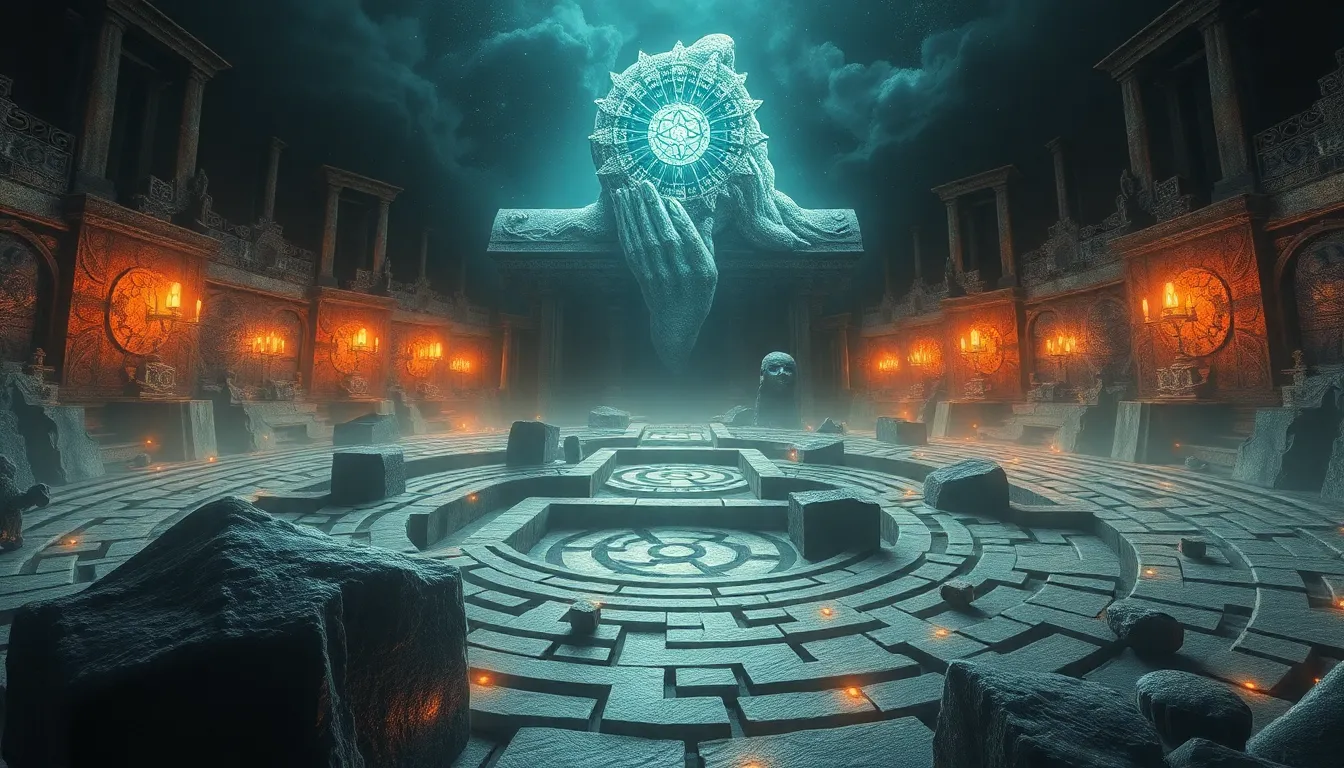The Sacred Labyrinths of the Mind: Mythology and Psychology
I. Introduction
Labyrinths have long fascinated humanity, serving as powerful symbols in both mythology and psychology. These intricate structures, characterized by their complex pathways and often convoluted designs, represent the multifaceted nature of the human experience. In mythology, labyrinths are often associated with tales of adventure and self-discovery, while in psychology, they symbolize the intricate workings of the mind.
This article aims to explore the sacred labyrinths of the mind, examining their historical significance, psychological interpretations, and cultural variations. By delving into the interplay between myth and mental processes, we hope to illuminate key themes such as the journey of self-discovery and the transformative power of navigating one’s inner labyrinth.
II. The Historical Significance of Labyrinths
Labyrinths have their origins in various ancient cultures, each attributing unique meanings and significance to these structures. The most famous example is the Labyrinth of Crete, designed by Daedalus to house the Minotaur, a creature that was half man and half bull. This mythological tale highlights the labyrinth as a place of both entrapment and potential liberation.
- Origins of labyrinths: Ancient civilizations, including the Egyptians, Greeks, and Mesoamericans, constructed labyrinths for various purposes, from religious rituals to entertainment.
- Symbolism in mythology: The story of Theseus and the Minotaur exemplifies the labyrinth as a metaphor for confronting one’s fears and the journey towards self-knowledge.
- Architectural and artistic expressions: Labyrinths have been represented in art and architecture, from the intricate designs in Gothic cathedrals to contemporary garden labyrinths.
III. The Psychological Interpretation of Labyrinths
In psychology, labyrinths serve as compelling metaphors for the human psyche. They represent the complex, often convoluted paths we must navigate in our minds as we seek understanding and healing.
Carl Jung, a prominent figure in psychology, proposed that the labyrinth can symbolize the journey into the unconscious mind. This journey involves exploring personal mythology, confronting repressed emotions, and ultimately achieving psychological balance.
- Metaphors for the psyche: Labyrinths express the struggles of the human condition—confusion, search for meaning, and the desire for resolution.
- Jung’s theories: Jung emphasized the importance of personal myths and archetypes in understanding oneself and achieving individuation.
- Psychological healing: Labyrinths are increasingly utilized in therapeutic practices, offering individuals a structured way to engage with their inner thoughts and feelings.
IV. Mythological Archetypes and the Labyrinth
Mythological figures associated with labyrinths, such as Ariadne and Daedalus, embody archetypal themes that resonate with the human experience.
- Ariadne: She represents the guide who provides the means (the thread) to navigate the labyrinth, symbolizing support and guidance in our personal journeys.
- Daedalus: As the architect, he symbolizes creativity and the ability to construct paths through complexity.
- Hero’s journey: The labyrinth serves as a stage for transformation, sacrifice, and ultimately, the hero’s return with newfound wisdom.
Understanding personal struggles through these mythological lenses allows individuals to contextualize their challenges and recognize their potential for growth.
V. The Labyrinth as a Tool for Self-Discovery
Navigating personal labyrinths can lead to profound self-discovery. Various techniques can aid in this exploration, including:
- Meditation: Quieting the mind and focusing on the labyrinth’s structure can help individuals access deeper insights.
- Art: Creative expression through drawing or sculpting labyrinths can facilitate self-reflection and emotional release.
Case studies of individuals who have engaged with labyrinths provide compelling evidence of their therapeutic potential. For instance, many report enhanced emotional clarity and a greater sense of purpose after walking a labyrinth.
Labyrinth walking is increasingly recognized as a meditative practice, offering numerous benefits, including:
- Improved focus and clarity of thought
- Reduction in anxiety and stress
- Enhanced connection to oneself and the surrounding environment
VI. Cultural Variations of Labyrinths in Myth and Psychology
Labyrinths manifest differently across cultures, reflecting diverse beliefs and practices.
- Western vs. Eastern traditions: Western labyrinths often emphasize a linear journey, while Eastern traditions may focus on cyclical paths, reflecting different philosophical perspectives on existence.
- Indigenous perspectives: Many indigenous cultures view labyrinths as spiritual symbols, representing the journey of life and the connection to the earth.
- Contemporary interpretations: Modern psychology incorporates labyrinths as tools for mindfulness and self-exploration, bridging ancient wisdom with contemporary therapeutic practices.
VII. The Neuroscience of Labyrinths
Recent research into the neuroscience of labyrinth navigation reveals fascinating insights into how our brains process complex pathways. Studies indicate that:
- The brain activates specific regions associated with spatial awareness when navigating labyrinths.
- Engaging with labyrinths can enhance cognitive function, supporting memory and problem-solving skills.
- Labyrinth walking has been shown to improve emotional well-being, reducing symptoms of anxiety and depression.
VIII. The Labyrinth in Literature and Art
Labyrinths have also found a significant place in literature and art, serving as powerful metaphors for the complexity of human experience.
- Literature: Classic works, such as Jorge Luis Borges’ “The Garden of Forking Paths,” explore the labyrinth as a symbol of choice and consequence.
- Artistic interpretations: Artists like M.C. Escher have used labyrinthine designs to challenge perceptions of reality and spatial relationships.
The influence of mythology and psychology on artistic expression continues to inspire contemporary artists, highlighting the timeless relevance of labyrinths in exploring the human condition.




